Last updated on July 21st, 2023
The red and regal Northern Cardinal is an eye-catching songbird. Its fiery plumage stands out against snowy backdrops, making it a recurring theme for holiday ornaments and greeting cards. Beneath the beautiful exterior are surprising quirks. You may have seen these flying and foraging in your backyard, but how well do you know them? Read on for 50 interesting facts about Northern Cardinal.
Appearance
1. When early European settlers saw the bird, they marveled at its image. They saw an uncanny resemblance to the traditional clothes of Roman Catholic cardinals, with the crest and plumage reminding them of the crimson-red caps and robes.
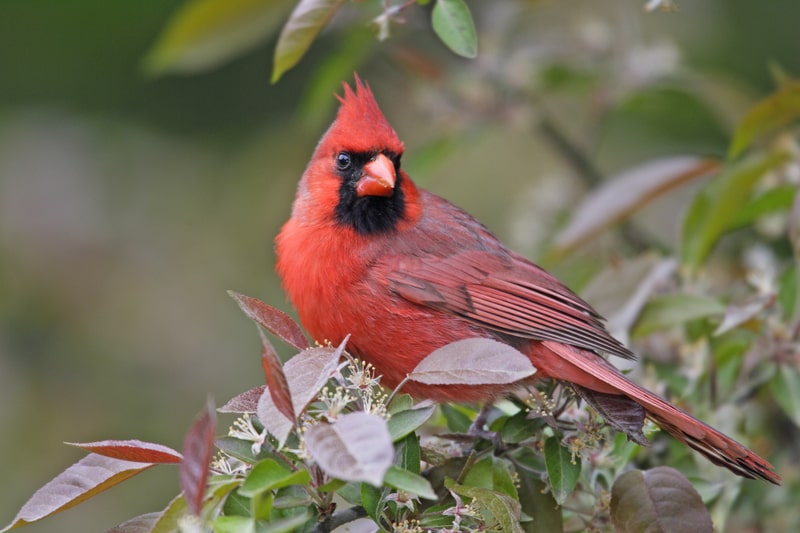
2. The face of the northern cardinal is covered in a dark mask extending from the eyes to the upper chest. The prominent black square in males creates an imposing aura. This mask may be gray and less defined in females.
3. These mid-sized songbirds can fly around with ease. They only weigh an average of 45 grams in adulthood. Their bodies are roughly 23 centimeters long, while their wingspans seldom exceed 30 centimeters or one foot.
4. Males are more colorful than females. It helps them stand out and attract mates. However, it is not uniform across their bodies. The bright red feathers at the front fade into a duller shade at the back and on the wings.
5. Female cardinals have it backward. They are predominantly grayish brown at the front. The dull color helps them blend better with their surroundings, protecting them from predators. Subtle red splashes appear on their wings, head, and tail.
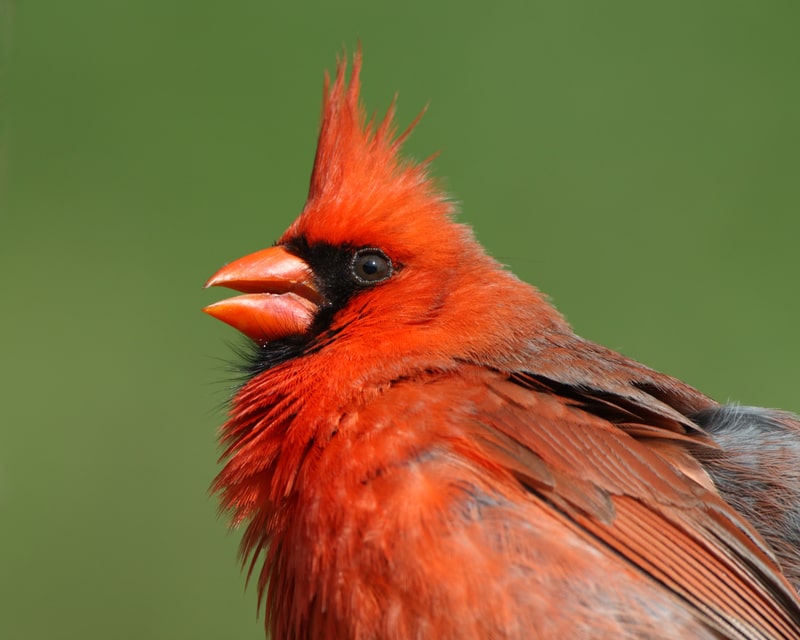
6. Cardinals have thick cone-shaped beaks for feeding and manipulating objects. For example, they can use it to crush and bend twigs when making nests. This beak has a bright coral shade.
7. Cardinals don’t need a barber. They shed their head feathers every summer. These bald birds look like small vultures – far from their usual picture-perfect appearance. Don’t worry! Replacements cover the scalp after a few weeks.
8. You can tell the mood of a northern cardinal by observing its head. Its distinctive crest acts like an eyebrow for humans. The feathers go higher when agitated and stay low when calm.
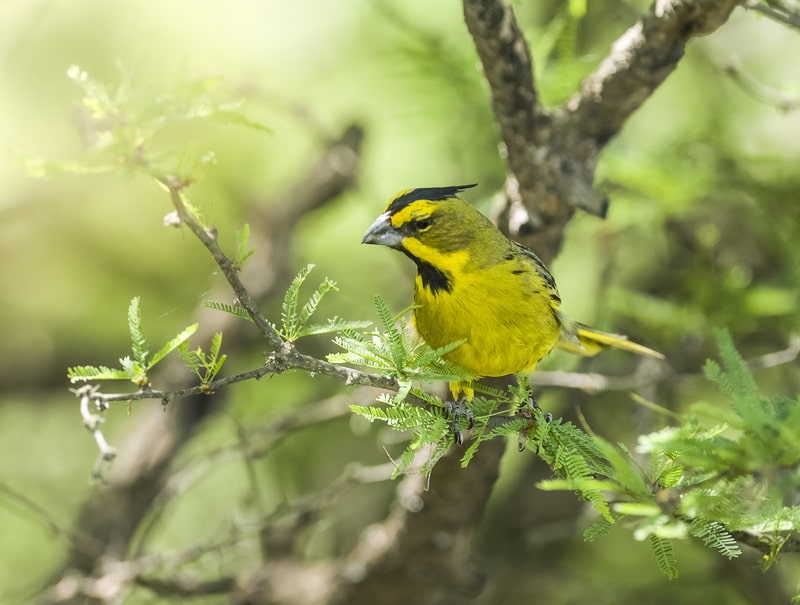
9. Yellow cardinals? Rare but real. They are not a separate species. These are northern cardinals, but the lack of a vital enzyme for pigment conversion prevents them from making red plumes. They still have black face, but their beaks and feathers are yellow.
10. The feathers get their color from food-based carotenoid pigments. They need both red and yellow to produce bright crimson plumage. In an experiment, male cardinals that only ate yellowish food still produced red feathers. However, these were pale and unappealing.
Behaviors
11. Many wild animals shiver to stay warm during cold periods. This continuous movement generates body heat. Cardinals apply this strategy by tensing their chest muscles. They can also lower their body temperature by three to six degrees.
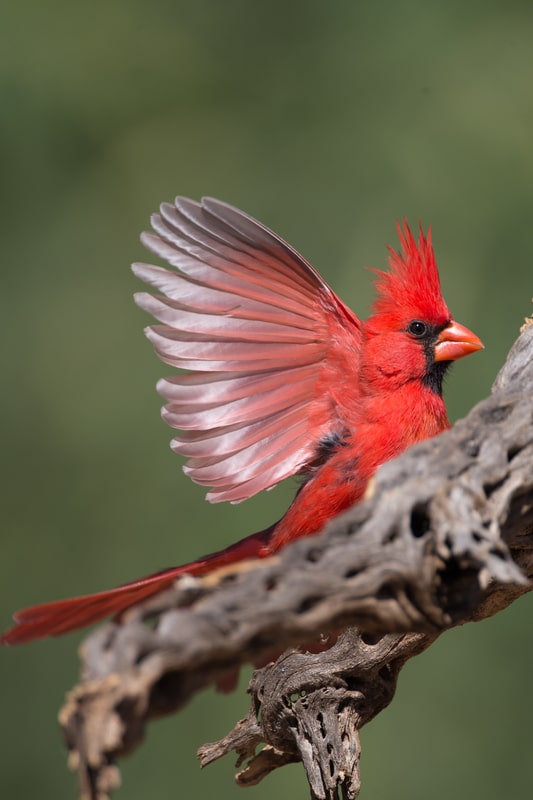
12. Cardinals stay within their range all year. When winter comes, they cope with the dropping temperatures by fluffing up their down feathers to retain warm air across the body. However, their bare legs are vulnerable to heat loss.
13. Cardinals are naturally drawn to wetlands, shrubs, and woods. They may also inhabit suburban gardens, especially when owners install bird feeders filled with food. These provide a lifeline when natural sources dry up.
14. Decades ago, cardinal sightings were limited to the southeastern part of the US. They gradually expanded their range northward, reaching Ontario and Quebec in Canada. They also pushed west to Arizona and California. Some made their way to Hawaii.
15. Male cardinals are territorial. They sing to declare their dominion over an area and chase anyone that dares to trespass. Sometimes they mistake their reflection for a rival, resulting in aggression against house windows and car mirrors. These one-sided fights can last for hours.
16. Cardinals learn songs from those around them, like a language passed on from generation to generation. Slight differences emerge when the birds move farther. There are noticeable regional variations in their songs.
17. Only the males sing in many bird species, but not so for cardinals. Even the females carry a tune, usually before nesting. The sounds they produce are different, with the females singing longer and more complex songs.
18. Cardinals produce roughly 16 types of calls. These can warn others about an approaching predator and other threats. They can also communicate about food, shelter, and nestlings. The birds repeat clear patterns multiple times.

19. Cardinals are all-in on hygiene. They love to splash around in bird baths and small pools of water. It helps them keep their feathers clean. They do it throughout the year, not minding the cold water during winter.
20. Northern cardinals hop on land with their heads on alert and their tails horizontal. When they sit on branches, these birds let go of their posture. They tend to hunch over and point their tail feathers straight down.
Random Facts
21. Cardinals can build a nest within three to nine days. It depends on the abundance of materials and the complexity of the structure. Finished nests are up to three inches tall and four inches across. The rim is one inch thick.

22. Cardinal eggs are tiny. They are less than an inch long and three-quarters of an inch thick. They have a smooth white shell with a blue, green, or brown tint. Blotches of gray and lavender appear around them.
23. The northern cardinal is the most beloved avian in the US, with seven states declaring it their official bird. These include Indiana, Illinois, Ohio, Kentucky, Virginia, West Virginia, and North Carolina. Delaware also considered it, but the title ultimately went to the Blue Hen.
24. Several professional sports teams chose the bird as their mascot. The most successful of these is the St. Louis Cardinals of the MLB. The “Red Birds” won 11 World Series titles. Meanwhile, the Arizona Cardinals have two NFL championships.
25. Cardinals are small but feisty. School-based athletic programs also turn to the songbird for inspiration for their college varsity teams. These include Illinois State University, Lamar University, Saint John Fisher College, Wesleyan University, and William Jewell College.
26. Bird lovers can finally take perfect shots of their backyard cardinals with the help of intelligent bird feeders. These are advanced devices with built-in cameras. They can detect different species, filter images, and send the best pictures to your phone.
27. You can’t keep Northern Cardinals as pets. They used to be popular options in shops, but it is now illegal to sell them. They are on the list of protected species in the Migratory Bird Treaty Act of 1918.
28. Climate change is projected to make the northern regions warmer. It may allow cardinals to expand their range upward. They are unlikely to lose their current territories. However, they may become more vulnerable to habitat destruction due to wildfires. Spring heat waves also threaten the life of nestlings.
29. Northern cardinals are close relatives of grosbeaks and buntings. Males of this group have brilliant plumages to attract mates ranging from red to blue. They breed in open-cup nests atop trees, with both parents heavily involved in child-rearing.
30. Winter is a period of fierce feeder battles. Birds with bigger bodies and longer bills tend to prevail, but size isn’t the only thing that matters. Solitary birds tend to dominate social birds. For example, the cardinal often loses feeder fights even with their kin around.
Feeding
31. Most of their diet consists of plant matter. Northern cardinals feast on fruits, seeds, and grains. They explore the ground for these food items, hopping from one spot to another for fresh finds.
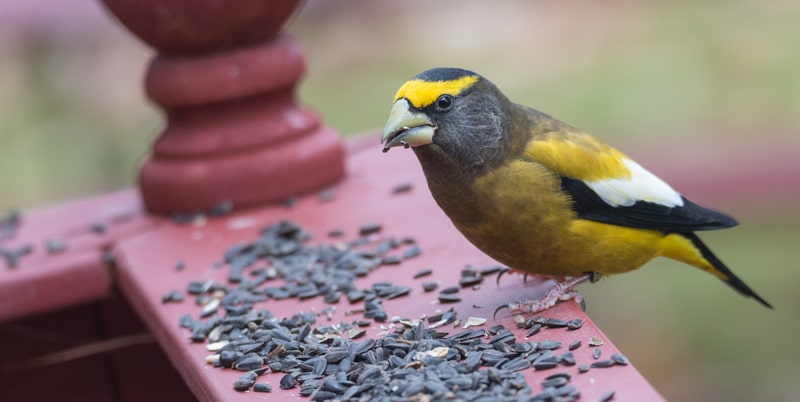
32. Cardinals are not picky. They will also feed on small animals if they are present in their surroundings. Snails, beetles, grasshoppers, and cicadas are among their favorites. Most parents feed insects to their young.
33. These birds seek maize, oats, tree bark, and sunflower seeds. Cardinals may also use the holes left by other birds on maple trees. These allow them to drink sweet sap with minimal effort.
34. During courtship, females may not need to forage for food as much. They can sit and wait for their partner. Males often bring them edible gifts to win their affection. In this intimate ritual, they feed the meals from beak to beak.
35. People who wish to see cardinals up close can install a bird feeder on their porches or gardens. Ensure that the design is suitable for these avians. Attract more visitors by offering their favorite food, like sunflower seeds.
Lifespan
36. Northern cardinals must always guard against birds of prey. They are no match for the much stronger falcons, owls, hawks, and eagles. They minimize encounters by hiding in shrubs and thick foliage.

37. Nests are always high above the ground, but some predators can still reach the eggs and chicks. Among these are fellow birds like crows and bluejays. Others are tree dwellers like Coluber constrictors and milk snakes. Cats, squirrels, and chipmunks may also climb the branches.
38. Life is short for most northern cardinals. They typically last only three years in the wild due to predatory pressure and food scarcity. However, they can exceed a decade under ideal conditions. Researchers even recorded a resilient 15-year-old female. In captivity, the oldest cardinal lived 28.5 years.
. . . continue reading on the next page
